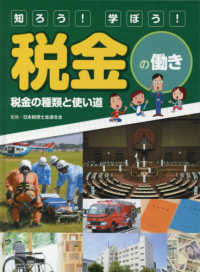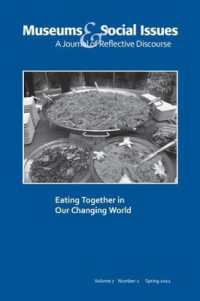- ホーム
- > 洋書
- > 英文書
- > History / World
Full Description
Rapa Nui, one of the world's most isolated island societies and home to the notable moai, has been at the centre of a tense debate for the past decade. Some see it as the site of a dramatic cultural collapse occurring before Western contact, where a self-inflicted ecocide was brought on by the exhaustion of resources. Others argue that the introduction of Western pathogens and the slave raids of 1862 were to blame for the near extinction of the otherwise resilient Rapa Nui people.
Cultural and Environmental Change on Rapa Nui brings together the latest studies by prominent Rapa Nui researchers from all over the world to explore the island's past and present, from its discovery by Polynesians, through the first documented contact with Western culture in 1722, to the 20th century. The exiting new volume looks beyond the moai to examine such questions as: was there was a cultural collapse; how did the Rapa Nui react to Westerners; and what responses did the Rapa Nui develop to adjust to naturally- or humanly-induced environmental change?
This volume will appeal to scholars and professionals in the fields of history, archaeology and ecology, as well as anyone with an interest in the challenges of sustainable resource management, and the contentious history of Rapa Nui itself.
Contents
Introduction: The Changing Rapa Nui Landscape and Environment. The editors, 1. Christopher M. Stevenson, Thegn N. Ladefoged, and Oliver Chadwick—Taking a Close Look at Ground Level: The Ancient Gardens and Population Dynamics on the Hiva Hiva Lava Flow, Rapa Nui, Chile, 2. Andreas Mieth and Hans-Rudolf Bork— Major Environmental Changes: A Vanished Landscape, and the Phenomena and Eco-cultural Consequences of Extensive Deforestation in the Prehistory of Rapa Nui, 3. Daniel W. Ingersoll and Kathleen B. Ingersoll— The Loss of the Rapa Nui Palms and a Consideration of Additional Possibilities Including Disease, Insects, and Animals, 4. John Flenley— New Interpretations of Pollen Data from Rapa Nui, 5. Joan Wozniak— Ingenious Strategic Responses When the Forest is Gone: Subsistence Developments on Rapa Nui (Easter Island), Prehistoric Gardening Practices on Rapa Nui and How They Relate to Current Farming Practices, 6. Burkhard Vogt and Annette Kühlem— New Rituals and Technology: By the Quebrada of Ava Ranga Uka A Toroke Hau, About Landscape Transformation and the Significance of Water and Trees, 7. Georgia Lee, Paul Bahn, Paul Horley, Sonia Haoa Cardinali, Lilian González Nualart, and Ninoska Cuadros Hucke— Cultural Persistence and Change: Re-use of the Sacred in Late Period Petroglyphs Applied to Red Scoria Topknots from Easter Island (Rapa Nui), 8. Jan J. Boersema— An Earthly Paradise? Easter Island as seen by the Eighteenth Century European Explorers, 9. Rhys Richards— Beyond Sustainability: Supplying the Outside World. The Impact of Whalers and other Foreign Visitors before 1862, 10. Kathleen B. Ingersoll, Daniel W. Ingersoll, and Andrew Bove— Healing a Culture's Reputation: Challenging the Cultural Labeling and Libeling of the Rapanui, 11. The Editors— Reflections
Index








